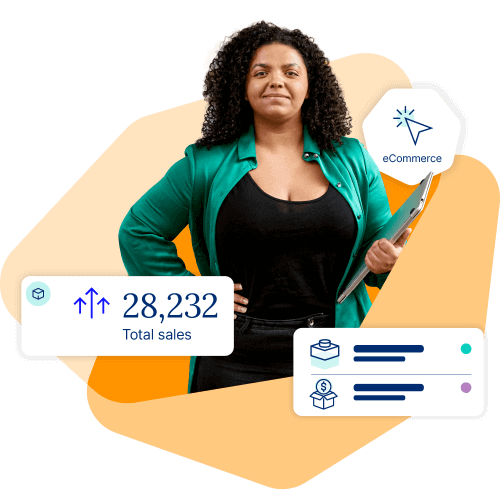

Modern businesses from every industry now operate across multiple states and countries. Thus, they need fast, efficient shipping services.
Freight shipping means transporting heavy or large volumes of goods, commodities, and cargo by land, sea, or air.
Freight shipping is important for any business that caters to people in different locations. Most ecommerce businesses serve customers worldwide, and often they partner with third-party logistics providers (3PL) for their freight shipping services.
According to FedEx, any shipment weighing over 150 pounds is considered freight. Any shipment under 150 pounds can be shipped as parcels. For instance, a microwave you booked online and delivered to your home is a parcel. A truck of microwaves shipped to the home appliance store is freight.
When goods are too heavy or delicate to be shipped by a standard ground shipping carrier, freight shipping is needed. Freight shipments involve packing items in wooden pallets or crates to keep them safe during transportation.
In general, freight shipping companies use ground, air and ocean transportation. The freight shipping company can recommend the best suitable mode of transportation based on your freight items and weight.
It’s highly advisable to discuss the delivery options with your freight shipping partner. For instance, if your warehouse doesn’t have appropriate equipment for easy loading and unloading of goods, your freight shipping partner can help you with some loading equipment to unload goods at an additional cost.
Freight shipping companies often send messages with a tracking number and freight carrier details when the truck is on its way. After the freight reaches a nearby terminal, you will probably receive a call from the freight carrier. You can schedule an appointment date and time for your freight delivery. You can inspect the shipment for any damage before receiving it.
As an ecommerce business owner, you must clearly understand freight shipping options before collaborating with a 3PL. Thus, you can choose the best shipping method that suits your business requirements and customer needs. For instance, investing in reliable inventory management software is highly recommended if you sell your products on multiple ecommerce platforms. The software allows you to integrate with diverse shipping service providers and fulfill orders in multiple locations.
Let’s discuss the significant types of freight shipments used for commercial purposes.
Air freight is the ideal mode of transportation if you have to ship high-value items. Air shipment is more common in the pharmaceutical and medical industries. Though it comes with a substantial cost, the shipment reaches the customer faster.
Businesses with large goods that need to be shipped within the country prefer rail freight. It is inexpensive compared to other freight modes but it may take a longer time than a truck. Often, businesses use rail in combination with other transportation modes to ship freight.
Ocean freight is an alternative to air freight when you have to ship freight overseas. However, shipments can take a long time to reach their destination with ocean freight. If there is no urgency, ocean freight is a perfect choice.
Businesses go for FTL freight shipping when they have enough stock to occupy an entire truck. A standard truck can carry around 26 pallets or load more than 15,000 pounds. However, the load weight or the number of pallets varies with the freight shipping company. Thus, it is always advisable to ensure the limits with the freight service provider.
FTL is only cost-effective when you have enough stock that covers the entire truck. Since you will be paying the truck’s total cost, unlike other freight shipping methods, you should make optimal use of every space available in the truck. It may be worth the money as order deliveries are much faster in FTL, as there are no stoppages in the middle for delivery.
Businesses opt for LTL when they have minimum freight quantities. In other words, shipments heavier than a parcel but not large enough to occupy the entire truck space are ideal for LTL freight shipping. Generally, shipping companies set minimum and maximum weight limits for LTL freight shipping. The weight limit varies from one company to another but ranges from 150 to 15,000 pounds, around six pallets.
In LTL freight shipping, businesses will share truck space with other companies. For instance, the shipping company will collaborate with multiple businesses and accommodate their goods optimally in the available truck space.
The prime advantage of LTL shipping is paying for what you store, not the entire truck. However, the downside is that goods are often transferred to different trucks before being delivered to the destination, taking more time for delivery.
Another option between LTL and PTL is partial truckload (PTL). If your shipment is over 5,000 pounds or six pallets, PTL can be a cost-effective method for you. Otherwise, it works like the LTL freight shipping method. You split the cost of the truck with other businesses, and you pay for what you store. One advantage of PTL shipping is the relatively low chance of transferring goods to different trucks.
Intermodal shipping means shipping freight by two or more modes of transportation. With intermodal containers, freight companies move shipments between truck, train, and ship effortlessly. Businesses prefer intermodal shipping as the freight is moved in containers without manual handling of items. Moreover, it is pretty cost-effective as there are no labor costs.
Expedited freight shipping is the most expensive of all shipments and is reserved for emergency or time-bound shipments. Generally, expedited goods travel by air rather than by ship or rail, making it costlier. Plus, it also involves transporting goods in express shipping lanes for prompt delivery.
According to Grandview Research, the global same delivery market size is expected to grow at a compound annual growth rate (CAGR) of 20.3% from 2020 to 2027. The research further predicts that the market growth will be due to increasing urbanization, rapid ecommerce adoption, and evolving customer expectations towards delivery services.
As an ecommerce business owner, you should address the customer’s expectations of faster delivery. Shipping is a pivotal part of the supply chain as the order is closed only when the product reaches the customer safely and promptly.
Whether you own an online store, sell in multiple online marketplaces, or supply to major retailers like Walmart and Target, partnering with a 3PL company can be a winning supply chain strategy. However, before collaborating with a 3PL, knowing the basics of freight shipping and its costs can help you choose the ideal shipping method.
Shipping cost directly impacts your business’s profit or loss. Thus, keeping the shipping charges minimal while offering faster delivery to your customers becomes crucial for long-term success. In general, freight shipping costs depend on multiple factors, including
Based on these factors, you can narrow down the mode of transportation for your shipment. Especially for international shipping, you may need to choose between air and sea freight. For instance, some loads can be too big or too risky for air shipments. Thus, consider all factors before finalizing the shipment mode.
As an online retailer, you will ship products to customers all over the world. Partnering with the right shipping company can provide better customer service. Therefore, do your research before partnering with a shipping service provider.
The two most common shipping service providers are freight forwarders and third-party logistics providers (3PLs). Understanding how they work will help you choose the right service provider to align with your business objectives.
Freight forwarders are companies that move goods from your warehouse to your customer. They don’t really handle transportation or supervise drivers, but they actively manage your shipment. In short, they act as a mediator between you and the freight carrier. Freight forwarders often decide the mode of transportation – truck, air, or ocean for optimal order fulfillment.
Shipping carriers are generally expensive, but freight forwarders regularly deal with multiple shipping carriers, so they can get you better deals for your shipments. Freight forwarders have the expertise and in-depth knowledge of how various modes of transportation work. They are familiar with customs, as they often deal with importing and exporting goods.
So, freight forwarders can help you ship your products anywhere in the world.
A 3PL company can do all a freight forwarder can and manage the entire supply chain process. A reputed 3PL company will maintain your products in optimal condition, get you the best possible shipping costs, and ensure the right products reach the right customers when an order is placed. A 3PL company also handles reverse logistics.
Furthermore, a 3PL company allows you to receive orders from every sales channel and fulfill them seamlessly. By outsourcing your logistics to a 3PL company, you can focus on your business growth and customer experience.
As an ecommerce business owner, you will regularly ship your products to multiple locations, catering to diverse customers. Thus, managing logistics is as crucial as managing inventory for your business. Cin7’s multichannel inventory management system comes with around 700+ business tools like accounting, marketplace, 3PL warehouse, shipping, and more that connect all your orders, inventory, shipping, and workflows. It’s an all-in-one software that allows you to manage inventory, ship and track orders, monitor analytics, and more. Reach out to the Cin7 team for a quick demo now.


The primary goal of any retail business is to attract and retain customers. Learn how to attract customers to your store with these tips.

What is retail in this day-and-age? eCommerce has changed the landscape so quickly, it may be difficult for small or new businesses to see how or if a physical store fits in their strategy. Yes, the customers are out there and they continue to shop in store more than online, at least for the time […]

Jennifer Xidias on how Cin7’s inventory management integrations saves Peta+Jain time and hundreds of thousands of dollars, every year. One of the most quantifiable things in my decision to go with Cin7 as my software choice was not only its futuristic focus, but also the amount we could save on our IT spend. Most […]